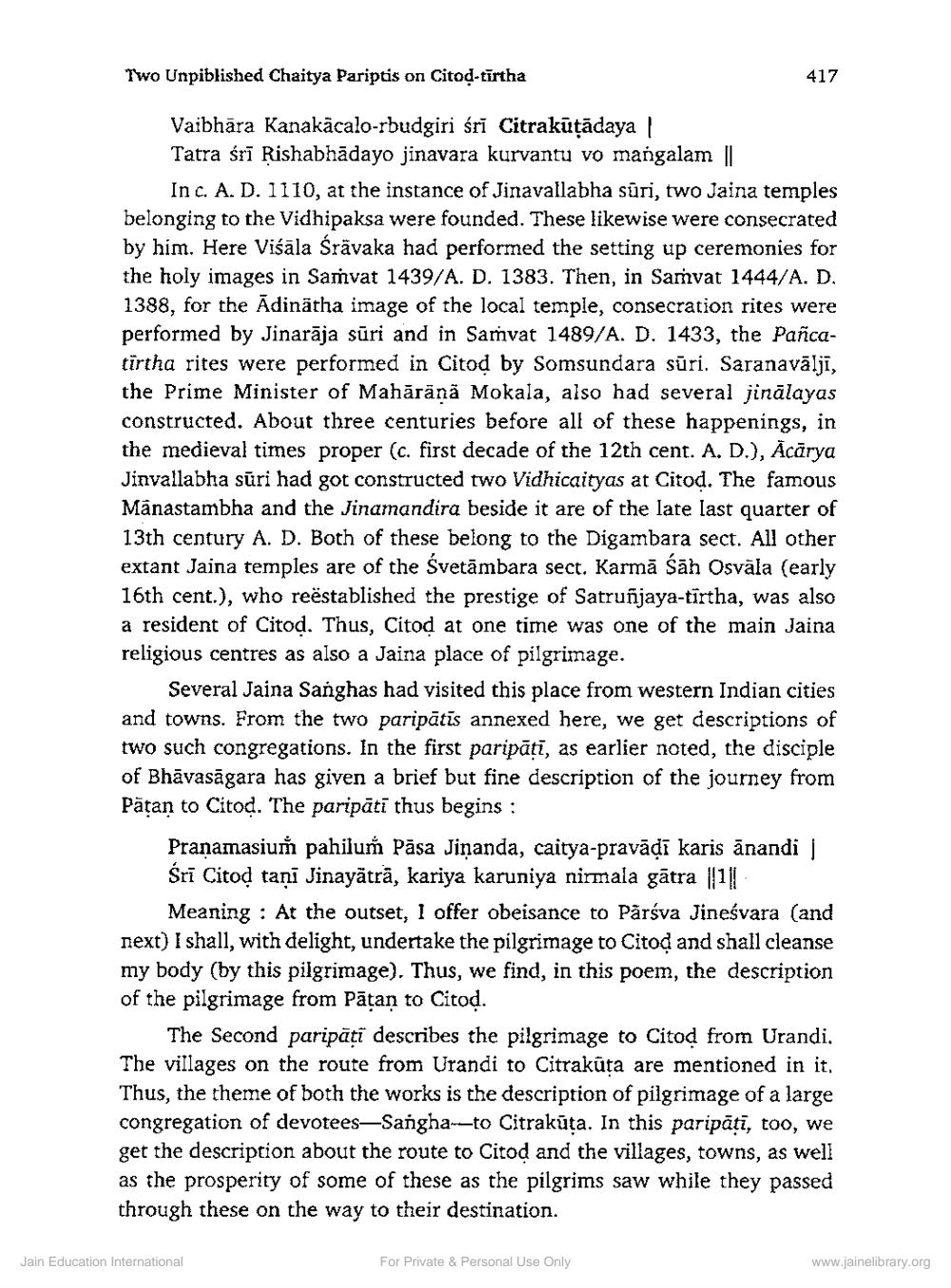Book Title: Two Unpublished Caitya Paripatis on Citod Tirtha Author(s): Jitendra B Shah Publisher: Z_Nirgranth_Aetihasik_Lekh_Samucchay_Part_1_002105.pdf and Nirgranth_Aetihasik_Lekh_Samucchay_Part_2 View full book textPage 4
________________ Two Unpiblished Chaitya Pariptis on Citoḍ-tirtha Vaibhāra Kanakäcalo-rbudgiri śrī Citrakūṭādaya | Tatra śrī Rishabhādayo jinavara kurvantu vo mangalam || In c. A. D. 1110, at the instance of Jinavallabha suri, two Jaina temples belonging to the Vidhipaksa were founded. These likewise were consecrated by him. Here Viśāla Śrävaka had performed the setting up ceremonies for the holy images in Samvat 1439/A. D. 1383. Then, in Samvat 1444/A. D. 1388, for the Adinatha image of the local temple, consecration rites were performed by Jinarāja sūri and in Samvat 1489/A. D. 1433, the Pañcatirtha rites were performed in Citod by Somsundara sūri. Saranavālji, the Prime Minister of Mahäränä Mokala, also had several jinālayas constructed. About three centuries before all of these happenings, in the medieval times proper (c. first decade of the 12th cent. A. D.), Acārya Jinvallabha sūri had got constructed two Vidhicaityas at Citod. The famous Manastambha and the Jinamandira beside it are of the late last quarter of 13th century A. D. Both of these belong to the Digambara sect. All other extant Jaina temples are of the Svetāmbara sect. Karmā Sāh Osvāla (early 16th cent.), who reestablished the prestige of Satruñjaya-tirtha, was also a resident of Citod. Thus, Citod at one time was one of the main Jaina religious centres as also a Jaina place of pilgrimage. 417 Several Jaina Sanghas had visited this place from western Indian cities and towns. From the two paripātis annexed here, we get descriptions of two such congregations. In the first paripăți, as earlier noted, the disciple of Bhāvasagara has given a brief but fine description of the journey from Patan to Citod. The paripati thus begins : Pranamasium pahilum Pasa Jinanda, caitya-pravāḍī karis ānandi | Śrī Citod tani Jinayätrā, kariya karuniya nirmala gātra ||1|| Meaning: At the outset, I offer obeisance to Parsva Jineśvara (and next) I shall, with delight, undertake the pilgrimage to Citod and shall cleanse my body (by this pilgrimage). Thus, we find, in this poem, the description of the pilgrimage from Patan to Citod. The Second paripăți describes the pilgrimage to Citod from Urandi. The villages on the route from Urandi to Citrakūta are mentioned in it. Thus, the theme of both the works is the description of pilgrimage of a large congregation of devotees-Sangha-to Citrakuta. In this paripāṭī, too, we get the description about the route to Citod and the villages, towns, as well as the prosperity of some of these as the pilgrims saw while they passed through these on the way to their destination. Jain Education International For Private & Personal Use Only www.jainelibrary.orgPage Navigation
1 2 3 4 5 6 7 8 9 10 11 12 13 14 15 16 17 18 19 20 21 22 23
